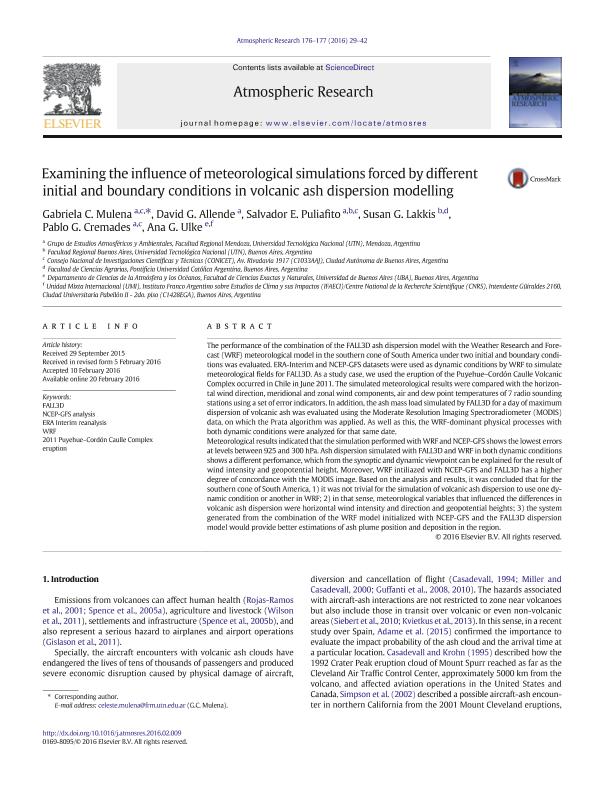Mostrar el registro sencillo del ítem
dc.contributor.author
Mulena, Gabriela Celeste

dc.contributor.author
Allende, David Gabriel

dc.contributor.author
Puliafito, Salvador Enrique

dc.contributor.author
Lakkis, Susan Gabriela

dc.contributor.author
Cremades, Pablo Gabriel

dc.contributor.author
Ulke, Ana Graciela

dc.date.available
2022-12-02T17:33:09Z
dc.date.issued
2016-02
dc.identifier.citation
Mulena, Gabriela Celeste; Allende, David Gabriel; Puliafito, Salvador Enrique; Lakkis, Susan Gabriela; Cremades, Pablo Gabriel; et al.; Examining the influence of meteorological simulations forced by different initial and boundary conditions in volcanic ash dispersion modelling; Elsevier Science Inc.; Atmospheric Research; 176-177; 2-2016; 29-42
dc.identifier.issn
0169-8095
dc.identifier.uri
http://hdl.handle.net/11336/180039
dc.description.abstract
The performance of the combination of the FALL3D ash dispersion model with the Weather Research and Forecast (WRF) meteorological model in the southern cone of South America under two initial and boundary conditions was evaluated. ERA-Interim and NCEP-GFS datasets were used as dynamic conditions by WRF to simulate meteorological fields for FALL3D. As a study case, we used the eruption of the Puyehue-Cordón Caulle Volcanic Complex occurred in Chile in June 2011. The simulated meteorological results were compared with the horizontal wind direction, meridional and zonal wind components, air and dew point temperatures of 7 radio sounding stations using a set of error indicators. In addition, the ash mass load simulated by FALL3D for a day of maximum dispersion of volcanic ash was evaluated using the Moderate Resolution Imaging Spectroradiometer (MODIS) data, on which the Prata algorithm was applied. As well as this, the WRF-dominant physical processes with both dynamic conditions were analyzed for that same date.Meteorological results indicated that the simulation performed with WRF and NCEP-GFS shows the lowest errors at levels between 925 and 300 hPa. Ash dispersion simulated with FALL3D and WRF in both dynamic conditions shows a different perfomance, which from the synoptic and dynamic viewpoint can be explained for the result of wind intensity and geopotential height. Moreover, WRF intiliazed with NCEP-GFS and FALL3D has a higher degree of concordance with the MODIS image. Based on the analysis and results, it was concluded that for the southern cone of South America, 1) it was not trivial for the simulation of volcanic ash dispersion to use one dynamic condition or another in WRF; 2) in that sense, meteorological variables that influenced the differences in volcanic ash dispersion were horizontal wind intensity and direction and geopotential heights; 3) the system generated from the combination of the WRF model initialized with NCEP-GFS and the FALL3D dispersion model would provide better estimations of ash plume position and deposition in the region.
dc.format
application/pdf
dc.language.iso
eng
dc.publisher
Elsevier Science Inc.

dc.rights
info:eu-repo/semantics/openAccess
dc.rights.uri
https://creativecommons.org/licenses/by-nc-sa/2.5/ar/
dc.subject
2011 PUYEHUE-CORDÓN CAULLE COMPLEX ERUPTION
dc.subject
ERA INTERIM REANALYSIS
dc.subject
FALL3D
dc.subject
NCEP-GFS ANALYSIS
dc.subject
WRF
dc.subject.classification
Meteorología y Ciencias Atmosféricas

dc.subject.classification
Ciencias de la Tierra y relacionadas con el Medio Ambiente

dc.subject.classification
CIENCIAS NATURALES Y EXACTAS

dc.title
Examining the influence of meteorological simulations forced by different initial and boundary conditions in volcanic ash dispersion modelling
dc.type
info:eu-repo/semantics/article
dc.type
info:ar-repo/semantics/artículo
dc.type
info:eu-repo/semantics/publishedVersion
dc.date.updated
2022-12-02T14:56:38Z
dc.journal.volume
176-177
dc.journal.pagination
29-42
dc.journal.pais
Países Bajos

dc.journal.ciudad
Amsterdam
dc.description.fil
Fil: Mulena, Gabriela Celeste. Universidad Tecnológica Nacional. Facultad Regional de Mendoza; Argentina. Consejo Nacional de Investigaciones Científicas y Técnicas. Centro Científico Tecnológico Conicet - Mendoza; Argentina
dc.description.fil
Fil: Allende, David Gabriel. Universidad Tecnológica Nacional. Facultad Regional de Mendoza; Argentina. Consejo Nacional de Investigaciones Científicas y Técnicas. Centro Científico Tecnológico Conicet - Mendoza; Argentina
dc.description.fil
Fil: Puliafito, Salvador Enrique. Consejo Nacional de Investigaciones Científicas y Técnicas. Centro Científico Tecnológico Conicet - Mendoza; Argentina. Universidad Tecnológica Nacional. Facultad Regional de Mendoza; Argentina
dc.description.fil
Fil: Lakkis, Susan Gabriela. Pontificia Universidad Católica Argentina "Santa María de los Buenos Aires". Facultad de Ciencias Agrarias; Argentina
dc.description.fil
Fil: Cremades, Pablo Gabriel. Universidad Tecnológica Nacional. Facultad Regional de Mendoza; Argentina. Consejo Nacional de Investigaciones Científicas y Técnicas. Centro Científico Tecnológico Conicet - Mendoza; Argentina
dc.description.fil
Fil: Ulke, Ana Graciela. Universidad de Buenos Aires. Facultad de Ciencias Exactas y Naturales. Departamento de Ciencias de la Atmósfera y los Océanos; Argentina. Consejo Nacional de Investigaciones Científicas y Técnicas; Argentina
dc.journal.title
Atmospheric Research

dc.relation.alternativeid
info:eu-repo/semantics/altIdentifier/url/http://www.sciencedirect.com/science/article/pii/S0169809516300266
dc.relation.alternativeid
info:eu-repo/semantics/altIdentifier/doi/http://dx.doi.org/10.1016/j.atmosres.2016.02.009
Archivos asociados
